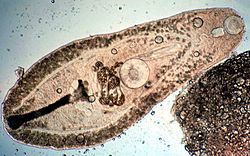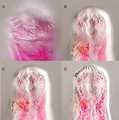Digenea facts for kids
Quick facts for kids Digenea |
|
|---|---|
 |
|
| Helicometra, an opecoelid digeneanfrom the intestine of a fish | |
| Scientific classification | |
| Kingdom: | |
| Phylum: | |
| Class: | |
| Subclass: |
Digenea
|
| Orders | |
|
Strigeidida |
|
Digenea are a special group of tiny flatworms. They are known as parasites, which means they live inside other animals and get all their food and shelter from them. They don't give anything back to their host! These worms usually have two strong suckers. One sucker is near their mouth (called the oral sucker), and the other is on their belly (called the ventral sucker). They use these suckers to hold on tightly inside their host's body.
Contents
What are Digenea?
Digenea are part of a larger group called trematodes, which are all parasitic flatworms. Unlike some other flatworms, Digenea have a very complex life. They often need to live inside two or more different types of animals to complete their life cycle. Imagine moving from a snail to a fish, and then maybe to a bird!
Where Do They Live?
Digenea can live in many different parts of their host's body. You might find them in the intestines, liver, lungs, or even the blood vessels. The animals they live in, called "hosts," can be almost anything. This includes snails, clams, fish, frogs, birds, and even mammals like humans.
How Do Digenea Live?
The life of a Digenea is like an amazing journey with many stages. It usually starts when eggs from an adult worm leave the first host (often a bird or mammal) and land in water.
- These eggs hatch into tiny swimming larvae that look like little snails.
- These larvae then find and infect a snail, which is usually their first "intermediate" host. Inside the snail, they multiply and change into new forms.
- Next, these new forms leave the snail and often swim to find a second intermediate host. This could be a fish, a crab, or even another snail.
- Inside this second host, they develop into a stage that can infect the "final" host.
- When the final host (like a bird or a human) eats the infected second host, the Digenea completes its journey and grows into an adult worm. The adult worm then lays eggs, and the cycle starts all over again!
Why Are Digenea Important?
Because Digenea are parasites, they can sometimes cause problems for their hosts. If an animal has too many Digenea worms, it can become sick. For example, some Digenea can cause diseases in fish, making them unhealthy. In some parts of the world, certain types of Digenea can even infect humans if they eat raw or undercooked seafood that contains the worms. However, with proper cooking, these risks can be avoided.
Images for kids
See also
 In Spanish: Digeneos para niños
In Spanish: Digeneos para niños


